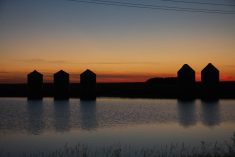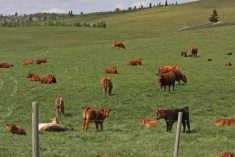CANMORE, Alta. – Workers on eight hour shifts caring for thousands of pigs are exposing their lungs to a bombardment of harmful particles clinging to dust.
Physician James Dosman of the University of Saskatchewan has been studying the health of hog barn workers since 1990 and has noticed an array of respiratory problems.
However, it is difficult to measure how many people are affected because workers will quit when they become ill. Others report no adverse affects.
“We don’t see most of the people. They quit work and then we don’t know what happens to them,” he said at the Canadian Agricultural Safety Association annual meeting in Canmore Nov. 16.
Read Also

Know what costs are involved in keeping crops in the bin
When you’re looking at full bins and rising calf prices, the human reflex is to hold on and hope for more. That’s not a plan. It’s a bet. Storage has a price tag.
The greatest risk to the workers is from dust and particles in the air in the barns.
An estimated 2.5 to three milligrams of dust are in a cubic metre of air. Among the toxins piggybacking on the dust particles are bits of animal feed, manure, dander, insect parts, mould, pollen, mineral ash and bacteria that could produce toxins that affect the walls of the lung.
Most people handle the particles but some end up with asthma or chronic air flow problems because their air passages are narrowed.
Spraying canola oil on the pigs and in the barns seems to help with dust control, but oil can make surfaces slippery, presenting another hazard.
Other problems may be alleviated by wearing a properly fitted N-95 mask. A study from the university found if people wore a mask for five hours their lung function improved.
Studies have also found workers who seem to suffer no ill effects.
An ongoing genetic study at the U of S shows a portion of the population carries a mutation called the TLR4 receptor where toxins are unable to penetrate cells and cause an ill response.
A study is going on among volunteer students where 29 with the mutation and 29 without enter hog barns to assess their breathing and other health issues.
Results are pending.















